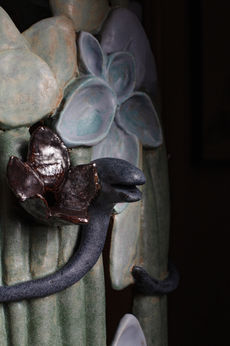
August 4, 2025 | VOL 15
HÉLOÏSE PIRAUD
CERAMICS is INHERENTLY UNCERTAIN
words Bike Çetinel
photos Anthony Girardi

The first sentence that stayed with me after my conversation with Héloïse Piraud—whose unique ceramic works I first encountered at Ceramic Brussels 2025—was: “Uncertainty is inherent to ceramics.”
Much like life itself! No matter how much we try to control or predict, things often take an entirely different course.
Héloïse’s sculptural pieces embody both control and unpredictability—or rather, a delicate balance between the two. This tension pushes the boundaries of clay even further. And in the end, the outcome is always the same: each piece becomes a tribute to the mesmerizing beauty of the process.
You blend ancestral techniques with contemporary innovations. How do you balance tradition and experimentation?
Working with clay inherently involves ancestral techniques, but I have a constant need to push boundaries. Through experimentation, I’ve developed my own methods, like weaving and inflating clay, expanding the limits of ceramics. While tradition grounds me, my work is firmly rooted in contemporary expression.
Uncertainty is central to your work. How does this theme influence your artistic process?
Ceramics is inherently uncertain. Shaping is precise, drying is delicate, and firing is unpredictable. A piece stays in the kiln for two 48-hour periods, and the result is never guaranteed. The form may shift, or colors may emerge unexpectedly. My process balances control and surrender, embracing both surprises and disappointments.
Your ceramics appear soft and inflated, yet they are solid. What inspires these forms, and how do you create them?
A few years ago, I started inflating clay with my breath, which changed my approach to ceramics. I wanted to evoke softness and squishiness in pieces that are actually hard and cold. They invite touch, yet in exhibitions, touching is forbidden. This tension between attraction and restriction fascinates me.
Accidents play a role in your work, yet you also control them. Can you share an instance where an accident led to a breakthrough?
While working on During a Love Sorrow, accident and chance shaped my approach. Some pieces developed a "motionless movement" effect, where the unexpected became integral. Though ceramics always involve unpredictability, I now work to minimize it, refining my control over the process while allowing just enough surprise to keep it alive.
How has your background in Art History and Archaeology influenced your ceramics?
Studying Art History and Archaeology trained me to observe art, architecture, and sculpture deeply. Museums, exhibitions, and research shaped my approach. Initially, I wanted to be an archaeologist, but I naturally transitioned to creating rather than documenting. For Ceramic Brussels, I drew inspiration from Egyptian, Armenian, and African archaeology.

I CONSCIOUSLY COLLECT AND ORGANIZE VISUAL REFERENCES, MUCH LIKE A DESIGNER OR COUTURIER. MY CREATIVE PROCESS INVOLVES COLLAGING IMAGES AND DRWAINGS
Your work is influenced by everyday shapes and colors. Can you share an unexpected inspiration?
I consciously collect and organize visual references, much like a designer or couturier. My creative process involves collaging images and drawings, often beginning with color. My gallerist once noted that my Flore & Faune piece resembled Georgia O’Keeffe’s work—I later realized I had a large O’Keeffe poster above my bed. Some floral motifs even stem from childhood drawings.
How does working in a shared ceramics studio in Montreuil impact your practice?
Each artist in the studio has a distinct practice, and it’s fascinating to see what emerges from the kilns. We exchange knowledge constantly. As my pieces grow in scale, I’m also grateful to have others around to help me handle and load them.
You’ve shown work at major fairs like PAD London and Design Miami. Do you focus on ceramic-specific exhibitions?
While I’ve participated in ceramic-focused fairs, I don’t limit myself to them. As my pieces become more substantial and narrative-driven, I’ve engaged in group shows and recently had my first solo exhibition. I believe art should not be confined by medium.














